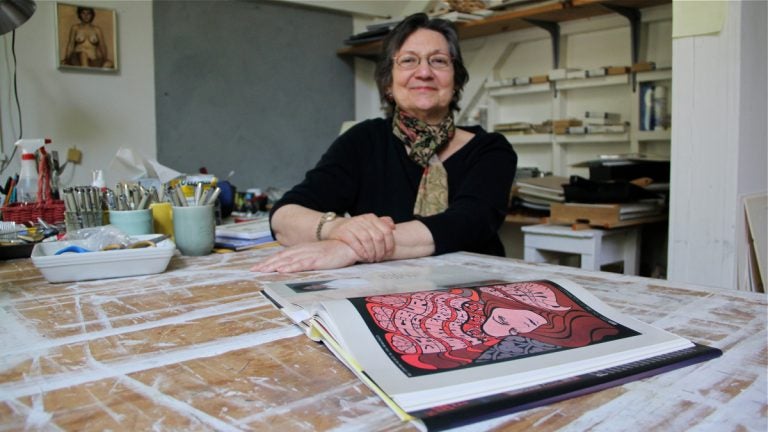Posters for new Fillmore Philadelphia are NOT psychedelic, thank you
Listen
Bonnie Maclean is known for her historical hand-drawn series of rock and roll posters made for the Fillmore Auditorium in the early 1960's-late 1970's. (Emma Lee/WHYY)
The Fillmore Philadelphia — a new music venue owned by Live Nation and named after the famous clubs in San Francisco and New York — will open Thursday in the Fishtown neighborhood.
The inaugural concert will be headlined by Philly’s R&B hitmakers Hall and Oates. The poster art for the concert, created by artist Bonnie MacLean, is a direct link to Fillmore’s psychedelic roots.
MacLean has been quietly painting figurative nudes and still lifes in a converted barn in Buckingham, Bucks County, for 43 years. Before that, she lived a fast-paced life in 1960s San Francisco. She moved there in 1963, when she says “Flower Power” still meant something.
“It was a nice idea at first, but with the Summer of Love all the kids came,” said MacLean. “They were teenagers. They had no money, couldn’t work, there was a lot of social decline. They got into drugs. I didn’t like to see that. It was unfortunate and sad.”
During that time, MacLean met and married Bill Graham, the rock impresario who famously booked the Fillmore with psychedelic rock, blues, jazz, R&B, and poetry, often on the same bill.
“I went to all the shows. When we were running the Fillmore, we were there around the clock. I saw all the shows, I loved that part of it,” said MacLean, who had a particular fondness for the British power trio Cream because they seemed more sophisticated than the local talent. “I gotta watch what I say. I don’t want to hurt anyone’s feelings. But that’s the way I saw it.”
MacLean had always had an interest in art, but no formal training. In college she studied French. After Graham’s regular poster artist, Wes Wilson, quit over a money dispute, Graham asked his wife if she would take a crack and designing posters. Between 1967 and 1972 she made 32 posters for the Fillmore.
Her work stood out for their almost classical structure: she liked to use Gothic architectural elements to frame the text, always centered around a face. The meat of the poster – the names of the bands, and the date, time, and place of the concert – would swirl around in bubbly letters.
“I was in that scene, I wanted to flow with what was happening,” she said.
Unlike a lot of her peers, MacLean never made her text unreadable.
“Some did that deliberately. They thought that’s what you should do. If it’s psychedelic, it should not be legible,” said MacLean. “That was never my thing. And Bill did not want it to be illegible. That’s not advertising. If you can’t read it, what’s the point?”
MacLean divorced Graham in 1975, remarried and relocated to rural Bucks County. She says what happened in San Francisco, stayed in San Francisco.
“I don’t work in a way influenced by those posters. I have no success in the world because of that. There’s no connection between that work and this work,” said MacLean, whose recent paintings are not shown in any gallery. “People collect posters, but they’re not interested in anything else I do.”
MacLean was approach by the Fillmore to design poster art for the Hall and Oates concert, which will be available to everyone at that sold-out show.
She says it will be in her old poster art style. Just don’t call it psychedelic.
“It’s my style, but I don’t know if it would qualify as that word anymore,” she said. “I made it, and I’m stuck with that word, whether I meant it or not.”
WHYY is your source for fact-based, in-depth journalism and information. As a nonprofit organization, we rely on financial support from readers like you. Please give today.





